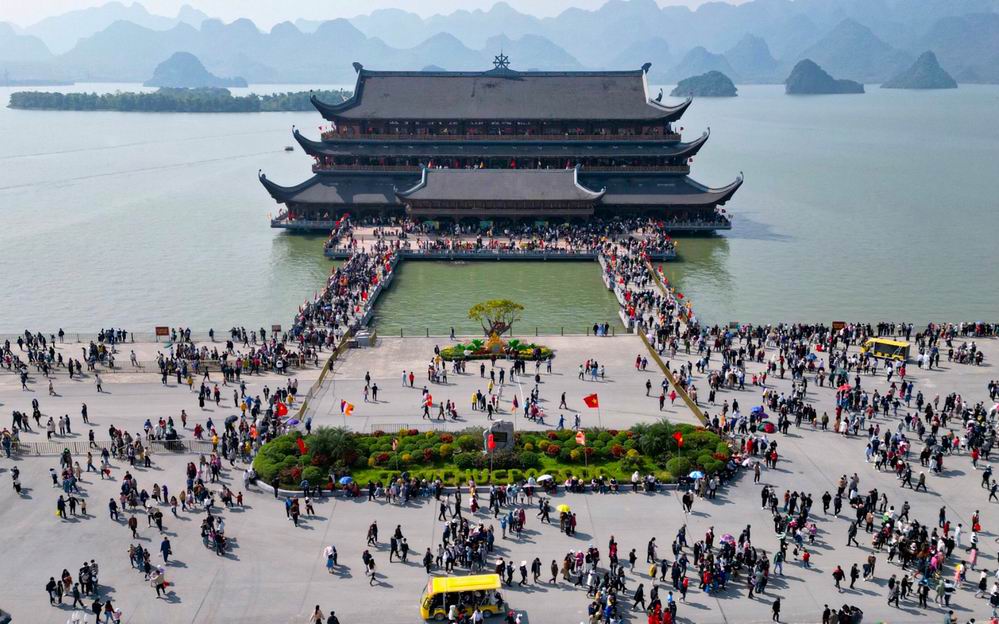Special national relics status for Tam Chuc and Co Le pagodas in Ninh Binh

Located in Tam Chuc ward, Ninh
Binh province, Tam Chuc scenic and archaeological site is
considered as "Ha Long Bay on land", with immense lake
landscape, majestic limestone mountains and diverse ecosystem.
This is not only the largest cultural and spiritual work in the
country but also contains many archaeological values, reflecting
traces of human habitation and activities in the past. The
discovery of relics and archaeological traces here further
clarifies the rich cultural history of Ha Nam land, which is the
intersection of many civilizations in the delta plain.
Tam Chuc Pagoda Complex with a large scale of over 5,000
hectares, including outstanding works such as Tam The Palace,
Phap Chu Palace, Quan Am Palace, Ngoc Tower, is not only a
destination for domestic Buddhists but also reaches
international level when it hosted the United Nations Vesak
Festival in 2019. The massive architecture combined with the
vast natural landscape has made Tam Chuc a major spiritual and
ecological tourism center in the North.
At the Tam Chuc scenic complex, archaeologists have discovered
many important traces, including human remains and three burials
(including double burials and reburials) dating back about
10,000 years - clear evidence of early human habitation. In
addition, many cultural artifacts were found such as Dong
Son-era pottery pieces, small stone tools of the Hoa Binh
culture, and sea mollusk shells and stream snails - showing that
this area was once a place where ancient residents lived,
exploited and used natural resources.
.
Being ranked as a special national monument further affirms that
Tam Chuc is not only a present-day pagoda but also a
"cultural-archaeological treasure", preserving long-lasting
historical evidence.
Co Le Pagoda - a mark of nearly 1,000 years of Vietnamese
Buddhism
If Tam Chuc impresses with its scale and modern beauty, the
historical relic and architectural art of Co Le Pagoda, Co Le
Commune, Ninh Binh Province is a vivid proof of the
long-standing Buddhist tradition of the nation. Co Le Pagoda,
named "Than Quang Tu", is a Buddhist cultural and architectural
work built in the 12th century, during the reign of King Ly Than
Ton, to worship Buddha and Saint Nguyen Minh Khong.
The highlight of Co Le Pagoda is the 32-meter-high Nine-Piece
Lotus Tower, a rare architectural symbol in Vietnam,
demonstrating the harmony between traditional construction art
and Buddhist philosophy. Not only is it a place of religious
pilgrimage, the pagoda is also associated with the Co Le
festival held in the 9th lunar month every year, attracting tens
of thousands of visitors from all over the world. The festival
with its Buddha procession rituals, peace-praying ceremonies,
and folk cultural activities has become an indispensable part of
the spiritual life of the people of Ninh Binh and the Northern
Delta region.
The recognition of Tam Chuc and Co Le as special national
monuments is a worthy recognition of two typical works of
Vietnamese Buddhism. One side is a spiritual and archaeological
complex of international stature, the other side is an ancient
pagoda that has existed for centuries. Both together create a
multifaceted picture of Vietnamese culture: both modern and
integrated, and ancient and profound.
The title of special national relic not only honors the value of
the past but also sets the responsibility for localities and
communities in preserving, conserving and promoting heritage.
This is also an opportunity for Ninh Binh to promote cultural
and spiritual tourism, linking heritage with socio -economic
development, and at the same time promoting the image of Vietnam
to the world. The two heritages honored today will continue to
spread their values, contributing to strengthening the national
cultural identity in the integration period.




